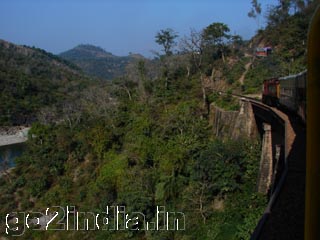
Kangra Valley is located in the western province of the state of Himachal Pradesh, India. It is 18 km south of Dharamshala and is one of the prettiest valleys of Himachal with its lush green terraces & orchards, overlooking a gushing stream - the Banganga.
Kangra valley routes out near Mandi, runs north, then bends west and extends to Shahpur near Pathankot.
The valley, sheltered by the sublime Dhauladhar range, is green and luxuriant. The area around Kangra is known for its old temples and serene surroundings and as a centre of the arts. Despite the onslaughts and political upheavels, the arts and crafts of the region continued to develop and found lyrical expressions. Crafts like the exquisitely designed shawls and miniature paintings of this region are internationally appreciated.
There are several tea gardens dedicated to the production of both green and black tea. The people of the valley are well built and are known for their dedicated services to the nation as soldiers. Kangra Valley, is an ideal place for adventure and sports activities like mountaineering, trekking, rock climbing and fishing , it is this valley which witness annually Hang-gliding rally.
Topography of the region allows existence of many peaks between 3500 m to 5000 m in Dhauladhar ranges. Most of the treks are operational from May to October. Pilgrims flock to Kangra in the month of April for the Navratra celebrations, and in September-October, before the Dussehra festival, to pay their homage to Goddess Durga at the Vajreshwari (Kangra Devi) temple.
Weather
The weather in Kangra is alpine. Summers (April-June) are mild and winters are cold (November-February). It experiences south-west monsoon rains in July-September. The Kangra region receives the second highest rainfall per annum. The best time to visit Kangra is between March and June.
Places to Visit in Kangra
There are many a attractions in the green picturseque valley to pay a visit. These include Brajeshwari Devi Temple, Kangra Fort, Maharana Pratap Sagar, Kangra Art Museum, Masroor, Dharamshala , Jwalamukhi Temple, Pong Dam Sanctuary.
Kangra Fort
This ruined historical structure, Nagar Kot is located 2.5 km south of the town, perched on a high windswept ridge. One can enjoy the panoramic view of the surroundings, which includes the confluence of Manjhi and Baner rivers from its top.
Maharana Pratap Sagar Dam
Named in honour of the great patriot Maharana Pratap (1572-97 AD), over the river Beas, the Pong dam was completed in 1976. Its reservoir covers an area of about 45,000 hectares at maximum possible flooding.The level varies every season and averages around 30,000
hectares. Over 200 villages with a population of over 85000 people lie along the wetland. The lake is well served by a network of roads.
Kangra Art Museum
This museum has miniature paintings from the Kangra school of art, which flourished in the Kangra valley during the 17th century, it also has elaborately embroidered costumes of Kangra people, woodcarvings and tribal jewellery
Jwalamukhi Temple
The famous temple of Jwalamukhi is 30kms. from Kangra and 56 kms from Dharamshala. Dedicated to the "GODDESS OF LIGHT", the temple is one of the most popular Hindu temples in northern India. There is no idol of any kind the flame is considered as a manifestation of the goddess. An eternally burning and shining blue flame emanates from the rock sanctum and is fed by the priests with the offerings of devotees. The golden tower (dome) of the temple was a gift from the Emperor Akbar.
Masroor
Known for its monolithic rock temples, Masroor is 15kms. south of Kangra. There are 15 rock cut temples in Indo-Aryan style and richly carved. The temples partly ruined now are profusely decorated with sculptural ornamentations , conceived in the same manner as the great temple of Kailash at Elora in Maharastra with which they bear a striking resemblance. The main temple is dedicated to Lord Ram, Lakshman and Sita.
Pong Dam Sanctuary
Pong Dam Sanctuary, the lake, created by damming the Beas River in 1976, lies in Kangra District on the border with Punjab State. The area under this Sanctuary is 32,270ha using digitised maps. The lake level fluctuates between 335m and 436m. All land above 440m within a 5km radius of the lake (an area of about 20,000ha) is notified as a buffer zone. Pong Dam Sanctuary lies between the outer Siwaliks and Daula Dhar, Pong Dam is the largest standing water body in Himachal Pradesh and covers about 7,000ha at its maximum extent. It includes
one permanent island (Ransar) and several others that are periodically connected to the shore. Five perennial streams flow south-west into the reservoir, namely Bul Khad, Dehr Kad, Dehri Kad, Gaj Khad and Baner Kad. Conditions are monsoonal, with hot humid summers and cool,
dry winters.
Brajeshwari Devi Temple
Just outside the town is the temple dedicated to Brajeshwari Devi. It was completely devastated in 1905 by an earthquake and then was rebuilt in 1920. A large number of devotees gather in the temple premises during various Hindu festivals.
To reach Kangra that is 170 km from Chandigarh, 110 km from Amritsar, 55 km. from headquarters at Dharamshala, the closest railway stations are at Mukerian 30 km, and Pathankot at 32 km. The closest airport is Gaggal 40 k.m.
![Reblog this post [with Zemanta]](http://img.zemanta.com/reblog_e.png?x-id=ca561d95-01c1-4aef-b684-fc14dff9bc35)
No comments:
Post a Comment